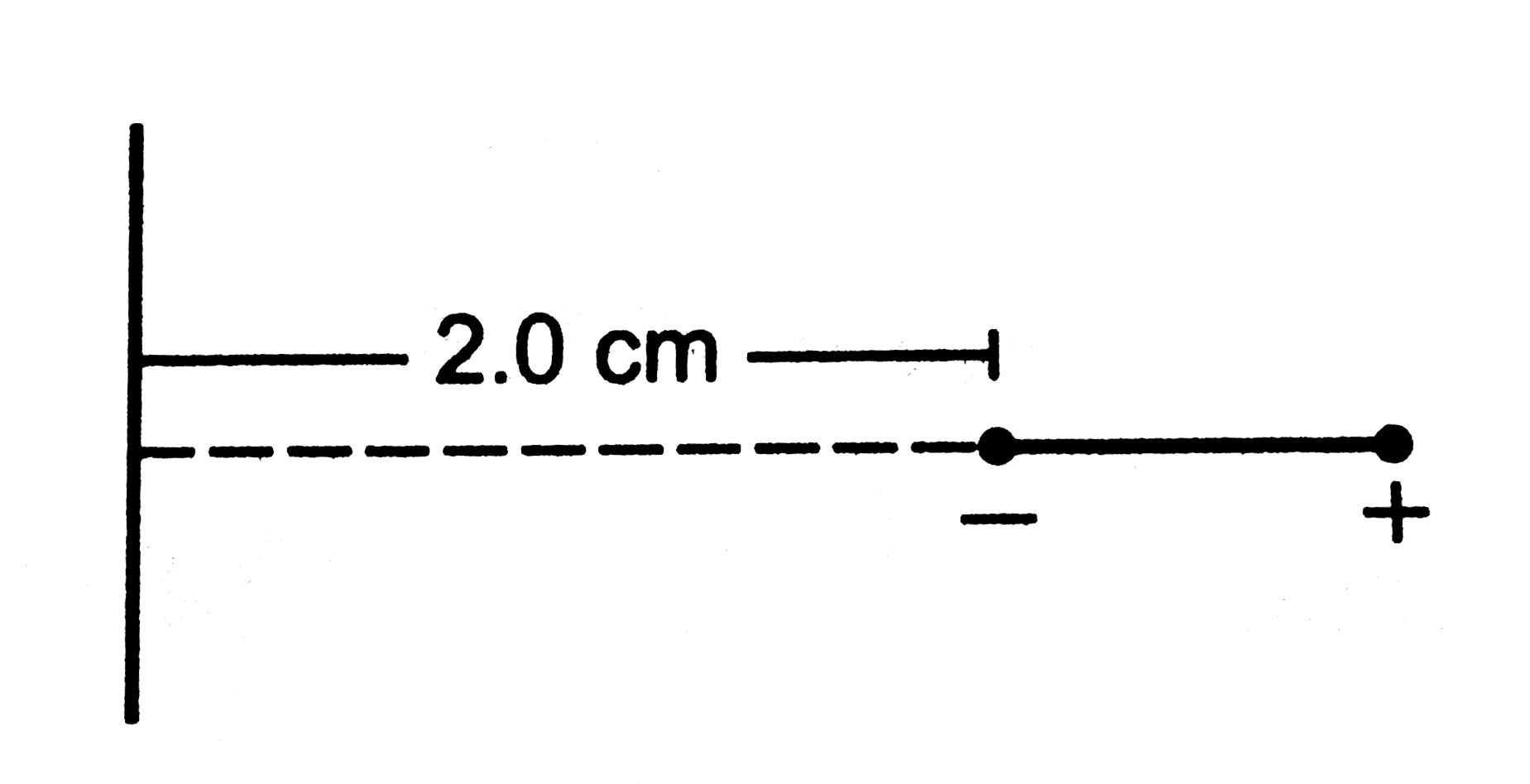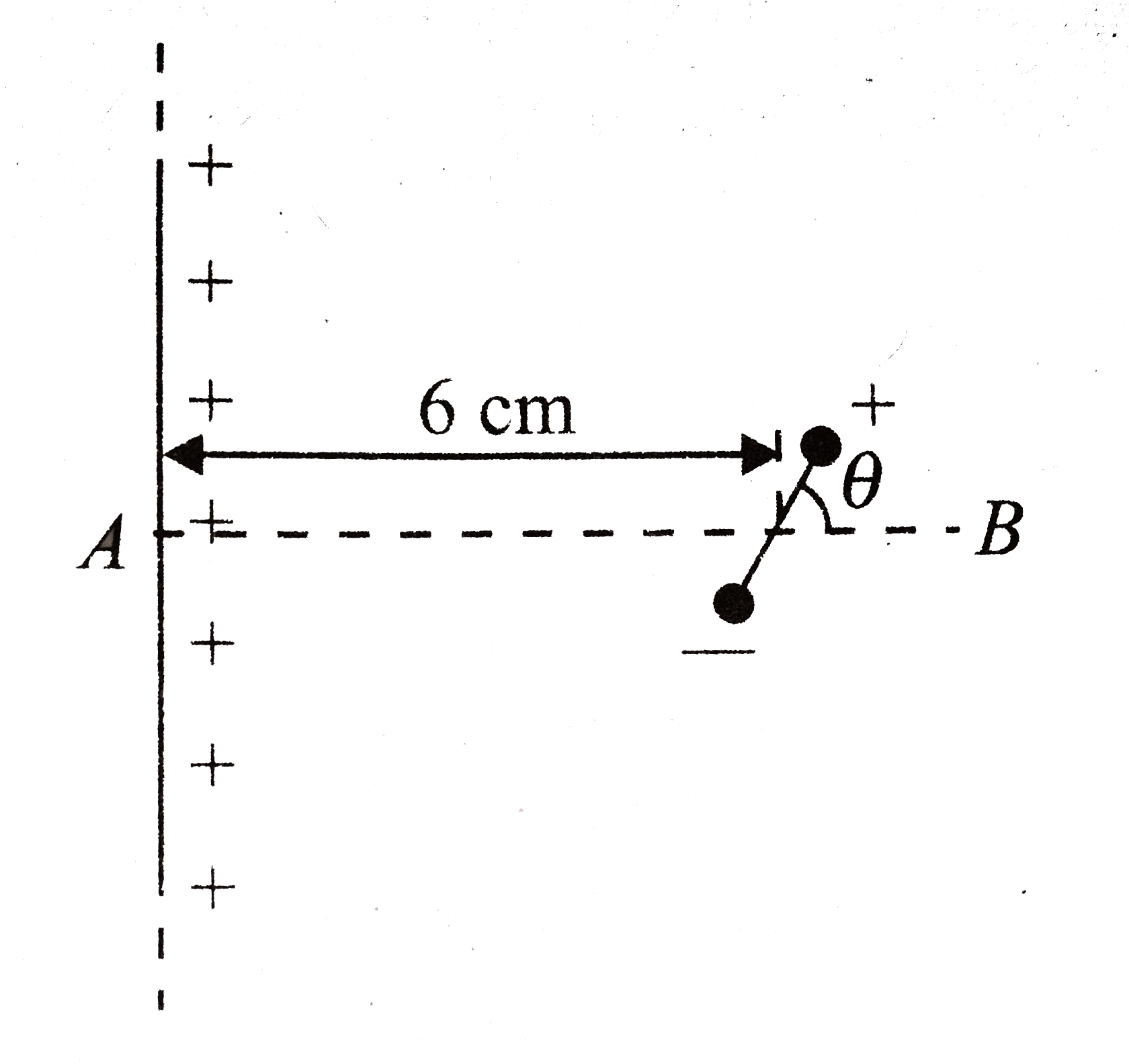An electric dipole consists of charges ±2.0×108C separated by a distance of 2.0×10−3 m. It is placed near a long ilne charge of linear charge density 4.0×10−4Cm−1 as shown in figure (30-W4), Such thet the negative charge is at a distance of 2.0 cm from the line charge. Find the force acting on the dipole.
 Solution in Tamil
Solution in Tamil
The electric field at a distance r from the line charge of linear density ≤mbda is given by
E=λ2πε0r.<br>Hence.Thefieldatthe¬ativechar≥is<br>E_1= (4.0 xx 10_(-4) C M^(-1) (2 xx 9 xx 10^9 N m^2 C^(-2)/0.02m<br>=3.6 xx 10^8 N C^(-1).<br>Theforceonthe¬ativechar≥is<br>F_1=(3.6 xx 10^8 N C^(-1) (2.0 xx 10^(-8) C)) +7.2N<br>→wardsthel∈echar≥.<br>Similarly,thefieldatthepositivechar≥,i.e.,<br>atr= 0.022 mis<br>E_2=3.3 xx 10^8 N C^(-1).<br>Theforceonthepositivechar≥is<br>F_2=(3.3 xx 10^8 N C^(-1) xx (2.0 xx 10^(-8) C))<br>=6.6N away from the line charge.
Hence, the net force on the dipole=(7.2-6.6)N<br>=0.6N toward the line charge.
Topper's Solved these Questions
- BOOK - HC VERMACHAPTER - GAUSS LAWEXERCISE - Short Question7videos
GAUSS LAW
- BOOK - HC VERMACHAPTER - GAUSS LAWEXERCISE - Objective 17videos
GAUSS LAW
- BOOK - HC VERMACHAPTER - GAUSS LAWEXERCISE - Exercises24videos
GAUSS LAW
- BOOK - HC VERMACHAPTER - ELECTROMAGNETIC WAVESEXERCISE - Exercise9videos
ELECTROMAGNETIC WAVES
- BOOK - HC VERMACHAPTER - GEOMETRICAL OPTICSEXERCISE - Exercises79videos
GEOMETRICAL OPTICS
Similar Questions
A small plane area is rotated in an electric field. In which orientation of the area is the flux of electric field through the area maximum? In which orientation is it zero.?
08:20View SolutionA charge Q is uniformly distributed over a large plastic plate. The electric field at a point P close to the centre of the plate is 10Vm−1. If the plastic plate is replaced by a copper plate of the same geometrical dimension and carrying the same charge Q the electric field at the point P will become
02:33View SolutionThe electric field in a region is given by →E=35E0→i+45E0→j with E0=2.0×103NC−1. Find the flux of this field through a recatngular surface of area 0.2m2 parallel to the y-z plane.
08:10View SolutionShow that the dimensions of the displacement current (ε0dΦEdt) are that of an electric current.
04:10View SolutionA concave mirror having a radius of curvature 40 cm is placed in front of an illuminated point source at a distance of 30 cm from it. Find the location of the image.
05:38View SolutionA spherical volume contains a uniformaly distributed charge of density 2.0×104Cm3. Find the electric field at a piont inside the volume at a distance 4.0 cm from the centre.
02:50View SolutionA charged partical having a charge of −2.0×10−6C is placed close to a nonconducting plate having a surface charge density 4.0 xx 10^(6) C m^(-2). Fine the force of attraction between the particle and the plate.
View SolutionAn electric dipole consists of charges +- 2.0 xx 10^(-8) C separated by distance of +- 2.0 xx 10^(-3) m. It is placed at a distance of 6 cm from a line charge of linear charge density 4.0 xx 10^(-4) Cm^(-1) as shown in figure such that the dipole makes an angle of theta = 60^@ with line AB. Find the force acting on the dipole.
View Solutionएक वैधुत द्विध्रुव 1.0×10−6 कूलॉम परिणाम तथा विपरीत प्रकृति के दो विधुत आवेशों से बना है । इन आवेशों के बीच की दुरी 2.0 सेमी है । इस द्विध्रुव को 1.0×105 न्यूटन/कूलॉम की बाह्य विधुत - क्षेत्र तीव्रता में रखा गया है । द्विध्रुव पर अधिकतम बल - आघूर्ण का मान निकालिए ।
04:01View SolutionAn electric dipole is prepared by taking two electric charges of 2 xx 10^(-8) C separated by distance 2 mm. This dipole is kept near a line charge distribution having density 4 xx 10^(-4) C/m in such a way that the negative electric charge of the dipole is at a distance 2 cm from the wire as shown in the figure. Calculate the force acting on the dipole. [Take k=1/(4piepsilon_(0)) = 9 xx 10^(9) Nm^(2)C^(-2) ]
04:36View SolutionA spherical volume contains a uniformaly distributed charge of density 2.0×10−4Cm3. Find the electric field at a piont inside the volume at a distance 4.0 cm from the centre.
08:42View SolutionAn electric dipole consisting of two opposite charges 2×10−6C each separated by a distance of 3cm is placed in an electric field of 2×105N/C. The maximum torque on the dipole will be
04:03View SolutionAn electric dipole consists of charges pm 2.0 xx 10^(-8) C separated by a distance of 2.0 xx 10^(-3)m . It is placed near a long line charger of linear charger density 4.0 xx 10^(4) C//m . As shown in figure, such that the negative charge is a distance of 2.0 cm from the line charge. Find the force acting on the dipole
01:42View SolutionAn electric dipole consists of two charges +- 20 xx 10^-6 C separated by a distance 2 xx 10^-3 m . Find electric field at a distance 0.10 m from the centre of the dipoie on the perpendicular bisector.
01:11View SolutionAn electric dipole consists of charges ±2.0×10−8 C separated by distance of ±2.0×10−3m. It is placed at a distance of 6 cm from a line charge of linear charge density 4.0×10−4Cm−1 as shown in figure such that the dipole makes an angle of θ=60∘ with line AB. Find the force acting on the dipole.
 05:11View Solution
05:11View SolutionAn electric dipole AB consists of charges +-5nC and seperated by distance 2xx10^(-3)m . The dipole is placed near a long line charge having linear charge density 4.5xx10^(-4)Cm^(-1) , such that the negative charge is at a distance OA=2.5 Cm from the line charge. Find the force acting on the dipole.
View Solution

